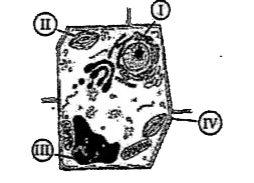With the help of diagram draw the parts of cells that are present both in animal and plant cells.
To answer the question about the parts of cells that are present in both animal and plant cells, we will follow these steps:
Step 1: Draw the Outline of the Cells
- Begin by drawing two separate cell outlines: one for the animal cell and one for the plant cell. The animal cell is typically round or oval, while the plant cell is more rectangular or box-like.
Step 2: Add the Cell Membrane
- Inside both cell outlines, draw the cell membrane. This is a thin layer that surrounds each cell. Label it as "Cell Membrane."
Step 3: Draw the Cytoplasm
- Next, fill the inside of both cell outlines with a shaded area to represent the cytoplasm. This is the jelly-like substance where organelles are suspended. Label it as "Cytoplasm."
Step 4: Include the Nucleus
- In both cells, draw a circle to represent the nucleus, which is the control center of the cell. Label it as "Nucleus."
Step 5: Add Vacuoles
- Draw a small vacuole in the animal cell and a larger vacuole in the plant cell. Label them as "Vacuole." Note that the vacuole is more prominent in plant cells.
Step 6: Finalize the Diagram
- Make sure to label all parts clearly and ensure that the diagram is neat. You can also add color to differentiate between the animal and plant cells.
Diagram Summary
- The final diagram should clearly show the following parts in both cells:
- Cell Membrane
- Cytoplasm
- Nucleus
- Vacuole (noting the size difference)
- Begin by drawing two separate cell outlines: one for the animal cell and one for the plant cell. The animal cell is typically round or oval, while the plant cell is more rectangular or box-like.
- Inside both cell outlines, draw the cell membrane. This is a thin layer that surrounds each cell. Label it as "Cell Membrane."
- Next, fill the inside of both cell outlines with a shaded area to represent the cytoplasm. This is the jelly-like substance where organelles are suspended. Label it as "Cytoplasm."
- In both cells, draw a circle to represent the nucleus, which is the control center of the cell. Label it as "Nucleus."
- Draw a small vacuole in the animal cell and a larger vacuole in the plant cell. Label them as "Vacuole." Note that the vacuole is more prominent in plant cells.
- Make sure to label all parts clearly and ensure that the diagram is neat. You can also add color to differentiate between the animal and plant cells.
- The final diagram should clearly show the following parts in both cells:
- Cell Membrane
- Cytoplasm
- Nucleus
- Vacuole (noting the size difference)
Topper's Solved these Questions
- CELL-STRUCTURE AND FUNCTIONSBOOK - PEARSON IIT JEE FOUNDATIONCHAPTER - CELL-STRUCTURE AND FUNCTIONSEXERCISE - CLASSROOM CORNER (Long Answer Type Questions )
14 Videos
- CELL-STRUCTURE AND FUNCTIONSBOOK - PEARSON IIT JEE FOUNDATIONCHAPTER - CELL-STRUCTURE AND FUNCTIONSEXERCISE - Competition Corner (M.C.Q)
49 Videos
- CELL-STRUCTURE AND FUNCTIONSBOOK - PEARSON IIT JEE FOUNDATIONCHAPTER - CELL-STRUCTURE AND FUNCTIONSEXERCISE - CLASSROOM CORNER (Very Short Answer Type Questions )Assertion -Reason
5 Videos
- CONSERVATION OF PLANTS AND ANIMALSBOOK - PEARSON IIT JEE FOUNDATIONCHAPTER - CONSERVATION OF PLANTS AND ANIMALSEXERCISE - COMPETITION CORNER
43 Videos
Similar Questions
Knowledge Check
........... are present only in plant cell.
APlastidsBAnimal cellCBoth of theseDNone of theseThe vacuoles present in animal cells are
Asmall, centrally located, and a few in numberBlarge, centrally located, and a few in numberCsmall, scattered, and more in numberDlarge, scattered, and more in numberMain difference between animal cell and plant cell is
AnutritionBgrowthCmovementDrespiration
Centrosome is present in animal cell.
View SolutionA plant cell with four labeled portions is depicted in the given figure.

The labeled organelle present in both animal cell and plant cell is
View SolutionName the plant parts where paranchymatous cells are present.
View SolutionWhat features are possessed by both plant cells and animal cells?
View SolutionName the plant parts where paranchymatous cells are present.
View Solution
